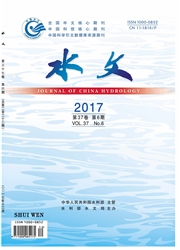

 中文摘要:
中文摘要:
分析了潮白河流域1991~2000年降水资料时空演变规律,采用同倍比放大法对各年的降水数据进行整体轮换处理,处理后各年总降水量为1991~2000年的平均年降水量。随后基于GBHM(Geomorphology-Based Hydrological Model)模型进行了10年径流量模拟。结果显示,在降水总量相同的情况下,1994年型降水时空分布最有利于产流,径流总量与峰值流量最大,1999年型径流总量与峰值流量最小。1994年型径流总量是1999年型径流总量的3.88倍;1994年型峰值流量是1999年型峰值流量的35.87倍。由此可见,降水总量相同时,其时空分布对径流总量和峰值的影响极大。
 英文摘要:
英文摘要:
This paper analyzed the Chaobai River Basin 1991-2000 spatial and temporal evolution of precipitation data, using the same-rate amplifying method to handle precipitation data of each year for overall rotation. After each treatment, the total rainfall for each year is the 1991 - 2000 average annual precipitation. Then based on GBHM (Geomorphology-Based Hydrological Model) model, we simulated the runoff of 10 years. The results show that in the same situation of total precipitation, spatial and temporal distribution of precipitation in 1994 is the most beneficial type for runoff, and its total runoff volume and peak flow reach maximums. The total runoff volume and peak flow in the 1999 type are minimums. The total runoff volume in the 1994 type is 3.88 times the total runoff volume in the 1999 type; the peak flow in the 1994 type is 35.87 times the peak flow in the 1999 type. Thus, with the same amount of precipitation, its spatial and temporal distribution has enormous impacts on the total runoffvolume and peak flow.
 同期刊论文项目
同期刊论文项目
 同项目期刊论文
同项目期刊论文
 期刊信息
期刊信息
